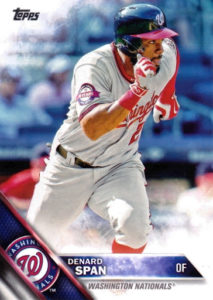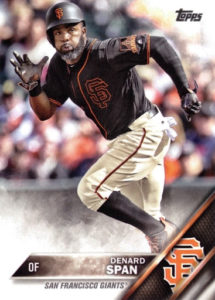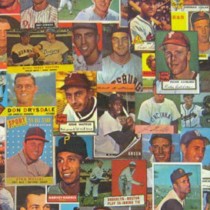Baseball Cards 101: Topps
Topps is the General Motors of the baseball card business. Just like General Motors produces cars and trucks under a variety of brands, such as Cadillac, Chevrolet, GMC and Buick, so too does Topps with its baseball cards. The number of brands that Topps issues is dizzying, and I frequently lose track. Among those I am familiar with are Opening Day, Heritage, Allen & Ginter, Bowman, Gypsy Queen and Archives. Their flagship offering is called Topps and in this post we’re going to take a look at it.
The design of baseball cards changes with each year. The size of the cards, for the most part, has been constant since 1957 when it took on its standard 2 ½” x 3 ½” configuration. Over the years we’ve seen a variety of designs and colors. I enjoy the annual change, especially when the new design pleases my eye. The 2017 issue, with its angles and lines at the base, threw me at first, but I’ve come to like it.

During any calendar year many players switch teams and Topps issues their cards in a manner that brings order to these changes. Every February Topps issues their first series of cards. It features 350 cards and is often loaded with star players as well as a small number of rookies. Before these cards hit the stores the off season business of baseball results in trades where players move from one team to another. Other players eligible for free agency frequently sign with another team as well. As a result of these moves, some of the players featured in the first series have already switched teams. That’s the case with star pitcher Chris Sale, whose 2017 first series card appears on the right. He was the center piece of a big trade this off season, and to land him the Boston Red Sox had to send four players to the Chicago White Sox.
Every year, in mid June, Topps releases its second series of cards. The number of cards in this series is once again 350 and will feature star players, everyday players, role players and rookies not included in series one.
Topps brings it all to a close every November when it releases its annual update series. This 300 card issue includes players who made the All Star teams appearing in their All Star uniforms, players from the Home Run Derby, players who changed teams, such as Chris Sale, as well as breakout rookies. Players who switch teams in trades made before the July 31st trading deadline will often appear in their new uniforms in this series as well.
In order to give you a visual example of a player who moved from one team to another, I’ll have to go back to last year’s issue. During the 2015 – 2016 off season, one of the best players to switch teams was outfielder Denard Span, who moved from the Washington Nationals to the San Francisco Giants. Here are his 2016 series one and 2016 update cards:


Bear in mind this is just the first of many posts about Baseball cards. Next time we’ll cover Baseball 102 – Insert Cards. To quote Art Fleming, this is where the score can really change.
Kindest regards until then.


Interesting blog post, Grubby. Keep ’em coming!
Thank you, Mohammed.